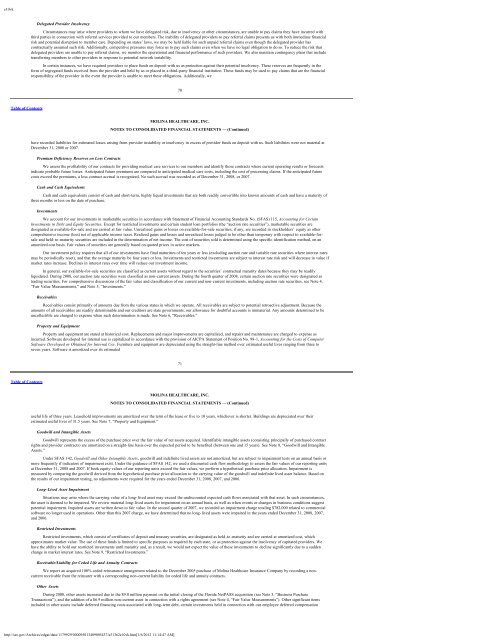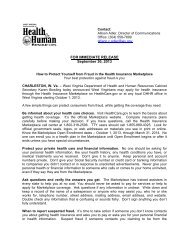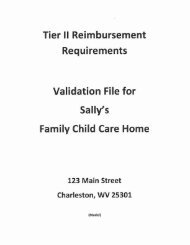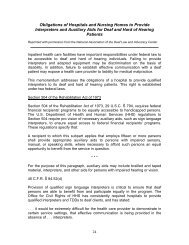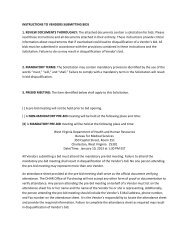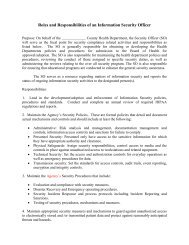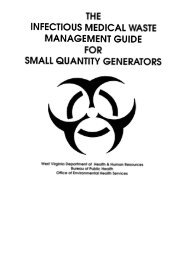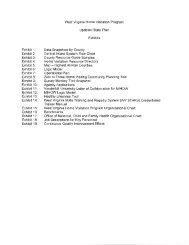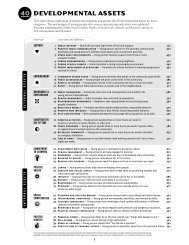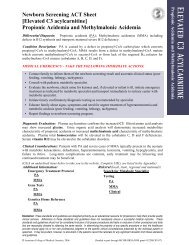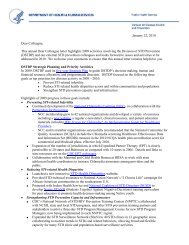Molina Medicaid Solutions - DHHR
Molina Medicaid Solutions - DHHR
Molina Medicaid Solutions - DHHR
Create successful ePaper yourself
Turn your PDF publications into a flip-book with our unique Google optimized e-Paper software.
e10vkDelegated Provider InsolvencyCircumstances may arise where providers to whom we have delegated risk, due to insolvency or other circumstances, are unable to pay claims they have incurred withthird parties in connection with referral services provided to our members. The inability of delegated providers to pay referral claims presents us with both immediate financialrisk and potential disruption to member care. Depending on states’ laws, we may be held liable for such unpaid referral claims even though the delegated provider hascontractually assumed such risk. Additionally, competitive pressures may force us to pay such claims even when we have no legal obligation to do so. To reduce the risk thatdelegated providers are unable to pay referral claims, we monitor the operational and financial performance of such providers. We also maintain contingency plans that includetransferring members to other providers in response to potential network instability.In certain instances, we have required providers to place funds on deposit with us as protection against their potential insolvency. These reserves are frequently in theform of segregated funds received from the provider and held by us or placed in a third-party financial institution. These funds may be used to pay claims that are the financialresponsibility of the provider in the event the provider is unable to meet these obligations. Additionally, we70Table of ContentsMOLINA HEALTHCARE, INC.NOTES TO CONSOLIDATED FINANCIAL STATEMENTS — (Continued)have recorded liabilities for estimated losses arising from provider instability or insolvency in excess of provider funds on deposit with us. Such liabilities were not material atDecember 31, 2008 or 2007.Premium Deficiency Reserves on Loss ContractsWe assess the profitability of our contracts for providing medical care services to our members and identify those contracts where current operating results or forecastsindicate probable future losses. Anticipated future premiums are compared to anticipated medical care costs, including the cost of processing claims. If the anticipated futurecosts exceed the premiums, a loss contract accrual is recognized. No such accrual was recorded as of December 31, 2008, or 2007.Cash and Cash EquivalentsCash and cash equivalents consist of cash and short-term, highly liquid investments that are both readily convertible into known amounts of cash and have a maturity ofthree months or less on the date of purchase.InvestmentsWe account for our investments in marketable securities in accordance with Statement of Financial Accounting Standards No. (SFAS) 115, Accounting for CertainInvestments in Debt and Equity Securities. Except for restricted investments and certain student loan portfolios (the “auction rate securities”), marketable securities aredesignated as available-for-sale and are carried at fair value. Unrealized gains or losses on available-for-sale securities, if any, are recorded in stockholders’ equity as othercomprehensive income (loss) net of applicable income taxes. Realized gains and losses and unrealized losses judged to be other than temporary with respect to available-forsaleand held-to-maturity securities are included in the determination of net income. The cost of securities sold is determined using the specific-identification method, on anamortized cost basis. Fair values of securities are generally based on quoted prices in active markets.Our investment policy requires that all of our investments have final maturities of ten years or less (excluding auction rate and variable rate securities where interest ratesmay be periodically reset), and that the average maturity be four years or less. Investments and restricted investments are subject to interest rate risk and will decrease in value ifmarket rates increase. Declines in interest rates over time will reduce our investment income.In general, our available-for-sale securities are classified as current assets without regard to the securities’ contractual maturity dates because they may be readilyliquidated. During 2008, our auction rate securities were classified as non-current assets. During the fourth quarter of 2008, certain auction rate securities were designated astrading securities. For comprehensive discussions of the fair value and classification of our current and non-current investments, including auction rate securities, see Note 4,“Fair Value Measurements,” and Note 5, “Investments.”ReceivablesReceivables consist primarily of amounts due from the various states in which we operate. All receivables are subject to potential retroactive adjustment. Because theamounts of all receivables are readily determinable and our creditors are state governments, our allowance for doubtful accounts is immaterial. Any amounts determined to beuncollectible are charged to expense when such determination is made. See Note 6, “Receivables.”Property and EquipmentProperty and equipment are stated at historical cost. Replacements and major improvements are capitalized, and repairs and maintenance are charged to expense asincurred. Software developed for internal use is capitalized in accordance with the provision of AICPA Statement of Position No. 98-1, Accounting for the Costs of ComputerSoftware Developed or Obtained for Internal Use. Furniture and equipment are depreciated using the straight-line method over estimated useful lives ranging from three toseven years. Software is amortized over its estimated71Table of ContentsMOLINA HEALTHCARE, INC.NOTES TO CONSOLIDATED FINANCIAL STATEMENTS — (Continued)useful life of three years. Leasehold improvements are amortized over the term of the lease or five to 10 years, whichever is shorter. Buildings are depreciated over theirestimated useful lives of 31.5 years. See Note 7, “Property and Equipment.”Goodwill and Intangible AssetsGoodwill represents the excess of the purchase price over the fair value of net assets acquired. Identifiable intangible assets (consisting principally of purchased contractrights and provider contracts) are amortized on a straight-line basis over the expected period to be benefited (between one and 15 years). See Note 8, “Goodwill and IntangibleAssets.”Under SFAS 142, Goodwill and Other Intangible Assets, goodwill and indefinite lived assets are not amortized, but are subject to impairment tests on an annual basis ormore frequently if indicators of impairment exist. Under the guidance of SFAS 142, we used a discounted cash flow methodology to assess the fair values of our reporting unitsat December 31, 2008 and 2007. If book equity values of our reporting units exceed the fair values, we perform a hypothetical purchase price allocation. Impairment ismeasured by comparing the goodwill derived from the hypothetical purchase price allocation to the carrying value of the goodwill and indefinite lived asset balance. Based onthe results of our impairment testing, no adjustments were required for the years ended December 31, 2008, 2007, and 2006.Long-Lived Asset ImpairmentSituations may arise where the carrying value of a long-lived asset may exceed the undiscounted expected cash flows associated with that asset. In such circumstances,the asset is deemed to be impaired. We review material long-lived assets for impairment on an annual basis, as well as when events or changes in business conditions suggestpotential impairment. Impaired assets are written down to fair value. In the second quarter of 2007, we recorded an impairment charge totaling $782,000 related to commercialsoftware no longer used in operations. Other than this 2007 charge, we have determined that no long-lived assets were impaired in the years ended December 31, 2008, 2007,and 2006.Restricted InvestmentsRestricted investments, which consist of certificates of deposit and treasury securities, are designated as held-to-maturity and are carried at amortized cost, whichapproximates market value. The use of these funds is limited to specific purposes as required by each state, or as protection against the insolvency of capitated providers. Wehave the ability to hold our restricted investments until maturity and, as a result, we would not expect the value of these investments to decline significantly due to a suddenchange in market interest rates. See Note 9, “Restricted Investments.”Receivable/Liability for Ceded Life and Annuity ContractsWe report an acquired 100% ceded reinsurance arrangement related to the December 2005 purchase of <strong>Molina</strong> Healthcare Insurance Company by recording a noncurrentreceivable from the reinsurer with a corresponding non-current liability for ceded life and annuity contracts.Other AssetsDuring 2008, other assets increased due to the $9.0 million payment on the initial closing of the Florida NetPASS acquisition (see Note 3, “Business PurchaseTransactions”), and the addition of a $6.9 million non-current asset in connection with a rights agreement (see Note 4, “Fair Value Measurements”). Other significant itemsincluded in other assets include deferred financing costs associated with long-term debt, certain investments held in connection with our employee deferred compensationhttp://sec.gov/Archives/edgar/data/1179929/000095013409005437/a51362e10vk.htm[1/6/2012 11:14:47 AM]


